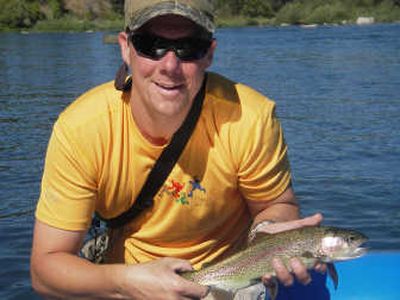Landers: Redbands in upstream battle

The Spokane River, and some of its native inhabitants, were in the spotlight Tuesday and Wednesday as a wide range of scientists, policy makers and industry leaders convened for the annual Spokane River Forum.
The redband trout – the river’s canary in the mineshaft – took stage at Centerplace in Spokane Valley for a couple hours among other presentations. The topics – a delicious assortment to a scientist – ranged from managing sewage overflows to setting fish consumption rates.
The redbands, a subspecies of rainbow trout, are struggling in Spokane River as it’s been altered by humans over the past 150 years despite evolutionary adaptations to everything nature threw at it for the preceding millennia.
The main limiting factors for these valuable fish involve habitat degradation, including siltation, shoreline development and barriers in the river and tributaries.
Also setting back the trout are pollution, poaching, flow and temperature variations and competition with smallmouth bass, an invasive species.
Anglers aren’t the only interests seeking a redband revival.
Native Americans consider redbands culturally essential, the last vestige of the dam-doomed salmon runs that focused the Spokane Tribe’s existence on the river.
Sean Visintainer said the Spokane River is a key resource for sales and outfitting in the eight years he’s owned Silver Bow Fly Shop.
Although he guides on other top regional fisheries, including the Clark Fork, St. Joe and Grande Ronde, he said 65 percent of his shop’s guiding last year was on the Spokane River.
An urban fishery has obvious advantages for Visintainer, who can save four to eight hours of travel time with each trip by fishing in his backyard. And every angler who fills a tank after a fishing trip to the Ronde knows how much an urban fishery saves in fuel costs.
“But it’s not good for just me,” he said.
“It’s good for the whole area to be known for a trout stream running through town. It distinguishes us.”
It’s attractive to visitors, knowing they can be fishing minutes from a downtown hotel and be off the water in time for shopping and a restaurant meal, he said.
“It’s also a good deal for a local resident, who can catch a couple hours of fishing after work.”
Visintainer would like to see a few more access sites for drift boats, a wish some independent anglers oppose in their quest to protect the struggling trout from too much pressure.
On the other hand, more legitimate anglers on the river would put more eyes out for poachers, who do significant harm to the fishery, state Fish and Wildlife officials say.
Fishing guides don’t necessarily need trophy trout to attract anglers, he said: “What they want is quality trout.”
The Spokane River fishery needs improvement but it doesn’t disappoint, he said, noting his clients average six to 15 hookups in a Spokane River float trip, and the average fish is a feisty 14 incher.
“In fact, what worries me most is that we don’t catch many small fish,” he said.
Thanks to federal dam relicensing requirements, Avista Utilities has taken on fisheries research and restoration projects to help mitigate the impact its five hydropower projects have had on fish and wildlife.
Tim Vore, who heads Avista’s fisheries research, said several years of work already is working in favor of redbands.
Studies documented 148 redband spawning beds in the 10 miles of free-flowing river downstream from Monroe Street dam in 2010, he said. Based on monitoring, the utility has a model of minimum flows to keep spawning areas covered with water during critical periods and guidelines for downramping dam flows to avoid stranding young fish.
Minimum flows also are being provided for more summer habitat.
The Spokane Conservation District is working on several fish habitat restoration projects with volunteer groups, especially in the upper river. Willows will be planted near Barker Bridge this spring and root balls will be anchored near Starr Road to provide young trout with protection from flows, a place to feed and cover from predators.
These projects also will help fish indirectly by producing aquatic insects essential to the trout’s diet.
Bugs are a big meal deal to trout that have seen their selection of groceries decline significantly in the past century. In 25 years, the number of invertebrate species found at Pine River Park has decreased from 54 to 10, according to Eastern Washington University research.
Harvey Morrison of Trout Unlimited said the local chapter has been working for five years with the Inland Northwest Land Trust and The Lands Council to plant willows along Hangman Creek to reduce the huge load of spawning bed-smothering sediment from upstream farming and shoreline abuse.
TU also has put up signs to alert anglers to fishing regulations aimed at protecting the river’s trout.
In the next few weeks, TU will be putting up signs printed in Russian to emphasize regulations to a group that’s been associated with not understanding them.
Redbands are in an upstream battle. Every little effort to help them is a step in the right direction.
Contact Rich Landers at (509) 459-5508 or email richl@spokesman.com.